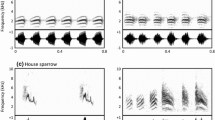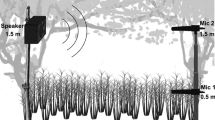Summary
Attenuation of pure tones was measured in marsh and grassland habitat. At surface level, in grassland, the ground effect strongly attenuated frequencies below 2.0 kHz (Fig. 2). The ground effect was reduced by increasing source-receiver elevation. In marsh habitat the ground effect did not occur, and low frequencies were optimal for sound propagation (Fig. 3). As predicted from sound propagation tests, analysis of recorded songs of seven grassland and six marsh species indicated that minimum and emphasized frequency were significantly lower in songs of marsh birds. Maximum frequency did not differ between habitats (Table 4). Buzzing songs of yellow-headed blackbirds were broadcast and re-recorded at 1 and 50 m from the speaker in marsh and grassland habitats. Low frequency components attenuated more rapidly than higher frequency components in grassland, and the reverse occurred in marsh. Results suggested that the ground effect restricts the use of low frequencies by grassland birds. This evidence is consistent with the ‘sound window’ hypothesis of Morton.
Similar content being viewed by others
References
Aylor D (1971) Noise reduction by vegetation and ground. J Acoust Soc Am 51:197–205
Bowman RI (1979) Adaptive morphology of song dialects in Darwin's finches. J Ornithol 120:353–389
Clench MH, Leberman RC (1978) Weights of 151 species of Pennsylvania birds analyzed by month, age, and sex. Bull Carnegie Mus Nat Hist 5:87
Delaney ME (1977) Sound propagation in the atmosphere: A historical review. Acustica 38:201–223
Falls JB (1981) Mapping territories with playback: An accurate census method for songbirds. Stud Avian Biol 6:86–91
Freund RJ, Littell RC (1981) SAS for linear models. SAS Institute, Cary, NC
Hunter ML, Krebs JR (1979) Geographical variation in the song of the great tit (Parus major) in relation to ecological factors. J Anim Ecol 48:759–785
Jilka VA, Leisler B (1974) Die Einpassung dreier Rohrsängerarten (Acrocephalus schoenobaenus, A. scirpaceus, A. arudinaceus) in ihre Lebensräume in bezug auf das Frequenzspektrum ihrer Reviergesänge. J Ornithol 115:192–212
Kendeigh SC (1941) Birds of a prairie community. Condor 43:165–174
Knapton RW (1979) Optimal size of territory in the claycolored sparrow, Spizella pallida. Can J Zool 57:1358–1370
Krebs JR, Davies NB (1981) An introduction to behavioural ecology. Sinauer, Sunderland, Mass
Marten K, Marler P (1977) Sound transmission and its significance for animal vocalization I. Temperate habitats. Behav Ecol Sociobiol 2:271–290
Marten K, Quine D, Marler P (1977)Sound transmission and its significance for animal vocalization II. Tropical forest habitats. Behav Ecol Sociobiol 2:291–302
Martin GR (1981) Avian vocalizations and the sound interference model of roberts et al. Anim Behav 29:632–633
Martin SG (1971) Polygyny in the Bobolink: habitat quality and the adaptive complex. PhD thesis, Oregon State University, Corvallis
Morton ES (1975) Ecological sources of selection on avian sounds. Am Nat 109:17–34
Nero RW (1950) A behavior study of the red-winged blackbird, II. Territoriality. Wilson Bull 68:129–150
Orians GH (1980) Some adaptations of marsh-nesting black-birds. Princeton University Press, Princeton
Orians GH, Christman GM (1968) A comparative study of the behavior of red-winged, tricolored, and yellow-headed blackbirds. Univ Calif Publ Zool 84
Piercy JE, Embleton TFW, Sutherland LC (1977) Review of noise propagation in the atmosphere. J Acoust Soc Am 61:1403–1418
Roberts J, Kacelnik A, Hunter HL (1981) The ground effect and acoustic communication. Anim Behav 29:633–634
Stewart RE (1953) A life history of the yellowthroat. Wilson Bull 65:99–115
Verner J (1965) Breeding biology of the long-billed marsh wren. Condor 67:6–60
Welsh DA (1975) Savannah sparrow breeding and territoriality on a Nova Scotia dune beach. Auk 92:235–251
Wiens JA (1973a) Interterritorial habitat variation in grasshopper and savannah sparrows. Ecology 54:877–884
Wiens JA (1973b) Pattern and process in grassland bird communities. Ecol Monogr 43:237–270
Willson MF (1966) Breeding ecology of the yellow-headed blackbird. Ecol Monogr 36:51–77
Zimmerman JL (1971) The territory and its density dependent effect in Spiza americana. Auk 88:591–612
Author information
Authors and Affiliations
Rights and permissions
About this article
Cite this article
Cosens, S.E., Falls, J.B. A comparison of sound propagation and song frequency in temperate marsh and grassland habitats. Behav Ecol Sociobiol 15, 161–170 (1984). https://doi.org/10.1007/BF00292970
Received:
Accepted:
Issue Date:
DOI: https://doi.org/10.1007/BF00292970




